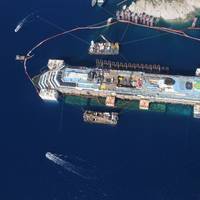Concordia Finally Heads for Scrapyard

The rusty hulk of the Costa Concordia began its journey to the scrapyard on Wednesday, after a two-year salvage operation off the Italian island where the cruise liner capsized two years ago, killing 32 people. Boats sounded horns and church bells rang as a tug boat slowly pulled the wreck of the liner, which was around two-and-a half times the size of the Titanic, away from the holiday island of Giglio, accompanied by a convoy of 14 vessels. Salvage workers gathered in bars at the port…
Costa Concordia: Operations to Tow the Wreck Begin
Maneouvres began early on Wednesday to remove the rusty hulk of the Costa Concordia cruise liner from the Italian island where it struck rocks and capsized two years ago, killing 32 people. A convoy of 14 vessels, led by the tug boat Blizzard, will start to tow the Concordia later on Wednesday to a port near Genoa in northern Italy where it is due to arrive on Sunday, before being broken up for scrap. Over the past week, salvagers have slowly lifted the 114,500-tonne ship from underwater platforms by pumping air into 30 large metal boxes, or sponsons, attached to the hull. Franco Porcellachia, engineer in charge of the salvage, said on Tuesday that his team had done everything in their power to make sure the ship…
Costa Concordia Refloated
The wreck of the luxury liner Costa Concordia was refloated on Monday and will soon be towed away and broken up for scrap, more than two years after it capsized off the Italian coast, killing 32 people. The 290-metre Costa Concordia ran aground on rocks near the Tuscan holiday island of Giglio in January 2012. The rusting hulk of the once gleaming-white ship had been resting on a temporary platform since being righted a year ago. In what has become one of the largest salvage operations in history, air was pumped into 30 large metal boxes, or sponsons, attached around the hull of the 114,500 tonne ship. The air forced out the water in the sponsons, lifting the vessel more than 2 metres off the underwater platform.









